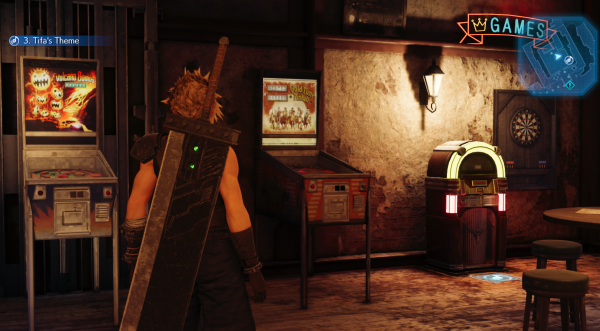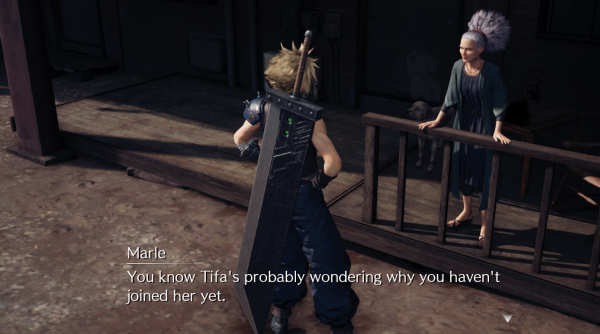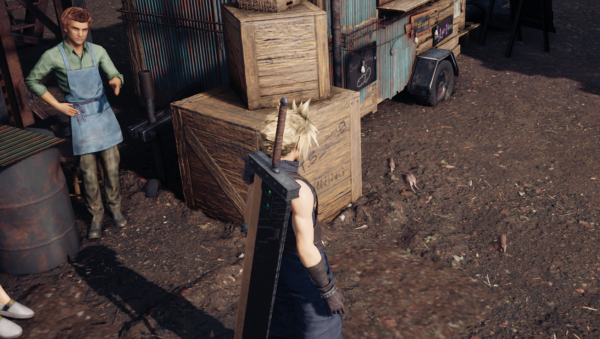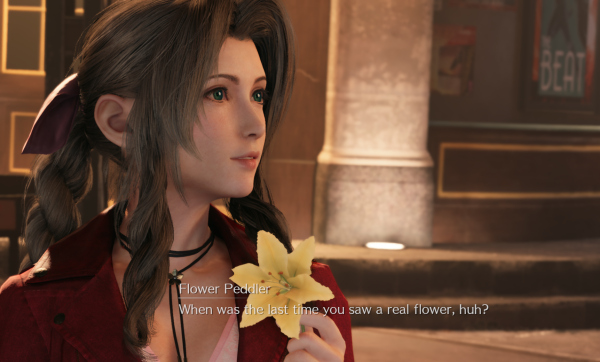Much of this time in Midgar sets up the prime conflict of Final Fantasy VII Remake: the nefarious Shinra Corporation drains mako energy from the planet, depleting the world’s natural vivacity and creating a cruelly unequal society. The lower classes reside literally beneath the more fortunate elites, with Midgar’s structural plates dividing the city into lavish upper levels and the impoverished ground-dwellers. Protagonist Cloud Strife finds himself in the revolutionary outfit Avalanche, driven to terrorism in their efforts to unravel Shinra’s environmental and economic tyranny. It all seems a simple struggle, with the player guiding Cloud in his defense of the oppressed underclasses.
Yet are Midgar’s alleged slum-dwellers really poor? Thanks to Final Fantasy VII Remake’s painstaking visual recast, we at last can see the truth.

Upon arriving in the Sector 7 Slums, Cloud drifts to the Seventh Heaven bar to reconnect with his childhood friend Tifa. Here we spy the first of many clues about just how well-off Midgar’s lowest neighborhood actually is. The bar has a television, a presumably robust supply of alcohol, a jukebox, a dartboard, and not one but two pinball machines! Avalanche leader Barret goes on ceaselessly about the injustices of Shinra, and Tifa sides with him. Yet if they’re so oppressed, why haven’t they sold these pinball machines to better their situation?

Other signs appear when Tifa shows Cloud to his apartment. While he’s just arrived and has no visible luggage, Cloud finds the room already furnished. Even a brief look around reveals some perfectly good tables, a few plastic containers, several books, a relatively unrusted toolbox, and two bottles of indeterminate toiletry product on the sink. The sink even has a mirror! And all this Cloud gets for free in what we're told is the worst district of Midgar!
And that's hardly the end of the revelations about this supposedly bleak and squalid place.

Traveling around brings even more telling sights. While many of the Midgar citizens who occupy the slums are dissatisfied with Shinra’s leadership and society’s stratification, all of these presumed unfortunates are clothed comparatively well. Some, such as Cloud’s landlady, are obviously able to afford necklaces and hair accessories.

Such is the craftsmanship in Final Fantasy VII Remake that Cloud even encounters rats underfoot throughout the area. Yet these rodents scurry about without anyone trying to capture and cook them. If this so-called slum is truly a grim and desolate warren of poverty and injustice, why has no one resorted to catching rats for a food source? Some residents are even seen lining up at restaurant stalls. Perhaps if they weren’t spending all that money eating out, they could afford a house in the upper Midgar districts.
And so we learn the truth about Midgar. Barret, Tifa and the other Avalanche members may rail against Shinra and its disparities, but we can plainly see that these so-called freedom fighters and the rest of the Midgar proletariat are just a flock of unmotivated and ungrateful lucky duckies who don’t known how good they have it. How much worse would these “slums” be if the purportedly evil practices of Shinra didn’t bring electricity and heat to their homes? And those enormous city-spanning plates overhead actually protect the lowest levels from all that unwanted rain and snow!

Truly, Cloud and his allies are nothing more than lazy malcontents who’d sooner dismantle a realistic but equitable society instead of finding the wherewithal to work hard, save money, and bootstrap their way up into well-paying Shinra jobs. The only redeemable member of the group is Aerith, who earns an honest living selling flowers instead of blowing up Shinra power plants and hanging out in bars. And she wouldn’t even have a job in the first place if Shinra’s reactors hadn’t killed off most of the city’s plant life, thus making her flowers into marketable curiosities.
Final Fantasy VII Remake is indeed a marvelous new vision. What appeared to be a tale of inequality and rebellion in the original game is exposed as a myth. Despite Shinra’s theoretical abuses, Midgar’s poorest denizens are still able to watch their televisions, play their pinball machines, don their jewelry, and feast upon their ratless delicacies.
We can only hope that the next Final Fantasy VII Remake title will further drive the point home. We’ll likely see Cloud and his charlatan compatriots leaving Midgar and continuing to crusade against the ills of a Shinra-run world—even though they enjoy that same world’s roads, inns, item shops, and Chocobo farms. Hypocrites, all of them.

No comments:
Post a Comment